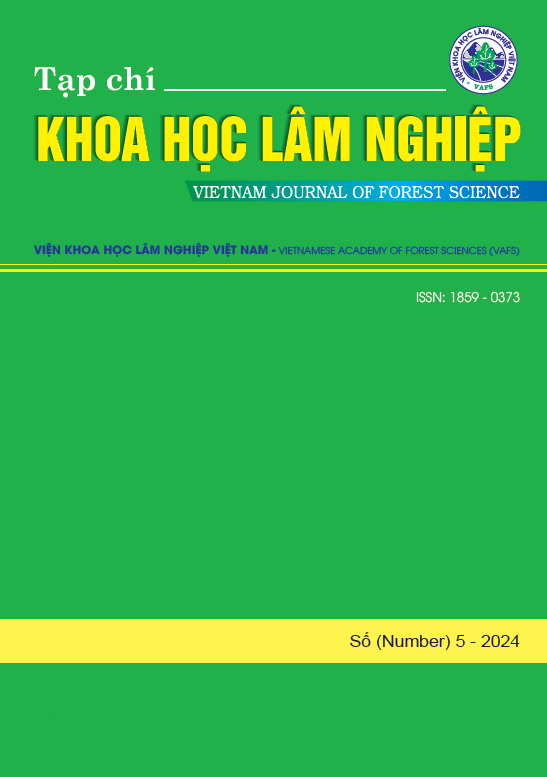ẢNH HƯỞNG CỦA MẬT ĐỘ TRỒNG ĐẾN KHẢ NĂNG SINH TRƯỞNG CỦA CÂY GÁO TRẮNG (Neolamarckia cadamba (Roxb.) Bosser) TRÊN HAI KIỂU ĐỊA HÌNH KHÁC NHAU Ở KHU VỰC LÂM ĐỒNG
DOI:
https://doi.org/10.70169/VJFS.953Keywords:
Neolamarckia cadamba, Kadamba tree, circular economy, growth, planting densityAbstract
The agroforestry economic model plays a significant role in the economic development of the Central Highlands region in particular and the entire country in general. In this study, we developed a model for planting Kadamba trees at different densities across various terrains in Lâm Đồng to assess their growth and development potential, aiming to select the most suitable model for a sustainable agricultural value chain. The results show that Kadamba trees planted on dry terrain exhibited superior height and trunk volume compared to those on semi-flooded terrain. Planting density was found to be inversely proportional to the development of trunk diameter, canopy diameter, and wood volume. The densities of 2,500 trees/ha (2m x 2m) and 1,100 trees/ha (3m x 3m) demonstrated better biomass growth efficiency compared to the other two densities. After 24 months of planting, the Kadamba trees reached a maximum height of 345.31 cm, a trunk diameter of 11.19 cm, a volume of 15,797.12 cm³, and a wood chemical composition C/N ratio of 34.52. The study indicates that selecting appropriate planting density and terrain conditions not only optimizes the growth of Kadamba trees but also opens up the potential for utilizing this wood species in mushroom production, contributing positively to the circular economy model.
References
Chang Shuting CS, Miles P, 2004. Mushrooms: cultivation, nutritional value, medicinal effect and environmental impact.
Chi VV, 2004. Từ điển thực vật thông dụng Tập 2. Khoa học kỹ thuật, 1447.
Chiến NV, 2014. Báo cáo tổng kết đề tài cơ sở “Bước đầu nghiên cứu chọn giống một số loài Gáo mọc nhanh phục vụ trồng rừng kinh tế”. Viện Khoa học Lâm nghiệp Việt Nam.
Chiến NV, 2016. Kết quả nghiên cứu chọn và nhân giống gáo trắng (Neolamarckia cadamba (Roxb.) Bosser) phục vụ trồng rừng kinh tế. Tạp chí KHLN, 16-26.
Dhaka R, Prajapati D, 2022. Growth attributes and wood properties of lesser-grown agroforestry tree species in the semi-arid zone for quality pulp and paper production. Journal of Agriculture and Ecology 13, 150-9.
Dung PC, 2020. a trial of neolamarckia cad am ba in Thanh Hoa province. Tạp chí Khoa học Trường Đại học Hồng Đức.
Krisnawati H, Kallio M, Kanninen M, 2011. Anthocephalus cadamba Miq.: ecology, silviculture and productivity. CIFOR.
Krisnawati H, Kallio MH, Kanninen M, 2019. Stand growth scenarios for jabon (Anthocephalus cadamba Miq.) plantation management in Indonesia. Agriculture and Natural Resources 53, 120-9.
Kumar A, Luna R, Parveen, Kumar V, 2010. Variability in growth characteristics for different genotypes of Eucalyptus tereticornis (SM.). Journal of Forestry Research 21, 487-91.
Lo H, Ko W, Chen W, Hsue H, Wu H, 1999. Flora Reipublicae Popularis Sinicae: Tomus 71 (1): Angiospermae Dictotyledoneae, Rubiaceae (1), 260–261. In.: Science Press, Beijing.
Minh VT, Ngọc PL, 2021. Đánh giá sự sinh trưởng, phát triển và năng suất của nấm rơm (Volvariella volvacea) trên các loại giá thể tái sử dụng sau sản xuất nấm. Tạp chí Khoa học và công nghệ nông nghiệp Trường Đại học Nông Lâm Huế 5, 2290-9.
Que Q, Li C, Li B, et al., 2021. Multi-level genetic variation and selection strategy of Neolamarckia cadamba in successive years. Forests 12, 1455.
Riany F, Siregar I, Sudrajat D. The growth and genetic potentials of gempol (Nauclea orientalis L.) as shading trees in urban landscapes. Proceedings of the IOP Conference Series: Earth and Environmental Science, 2018: IOP Publishing, 012002.
Sánchez C, 2009. Lignocellulosic residues: biodegradation and bioconversion by fungi. Biotechnology advances 27, 185-94.
Selvan RT, Parthiban K, 2018. Clonal evaluation and genetic divergence studies in Neolamarckia cadamba roxb. Electronic Journal of Plant Breeding 9, 692-704.
Soerianegara I, Lemmens R, 1993. Plant resources of southeast Asia. No. 5 (1). Timber Trees: Major Commercial Timbers, 384-91.
Stromberger ME, 2005. Fungal communities of agroecosystems. In. The Fungal Community. CRC Press, 833-52.
Sudarmo MK, 1957. Tabel hasil sementara Anthocephalus cadamba Miq. (jabon). Pengumuman No. 59. Lembaga Penelitian Kehutanan, Bogor, Indonesia, 13.
Sudrajat DJ, Nurhasybi N, Siregar IZ, Siregar UJ, Mansur I, Khumaida N, 2016. Intraspecific variation on early growth of Neolamarckia cadamba Miq. in provenance-progeny tests in West Java Province, Indonesia. Biotropia 23, 10-20.
Thảo VN, 2016. Báo cáo tổng kết đề tài: Nghiên cứu chọn giống và kỹ thuật gây trồng Gáo trắng (Neolamarckia cadamba (Roxb.) Bosser), Gáo vàng (Nauclea orientalis (L.) L) trên vùng đất phèn ở Nam Bộ. Viện Khoa học Lâm nghiệp Việt Nam.









